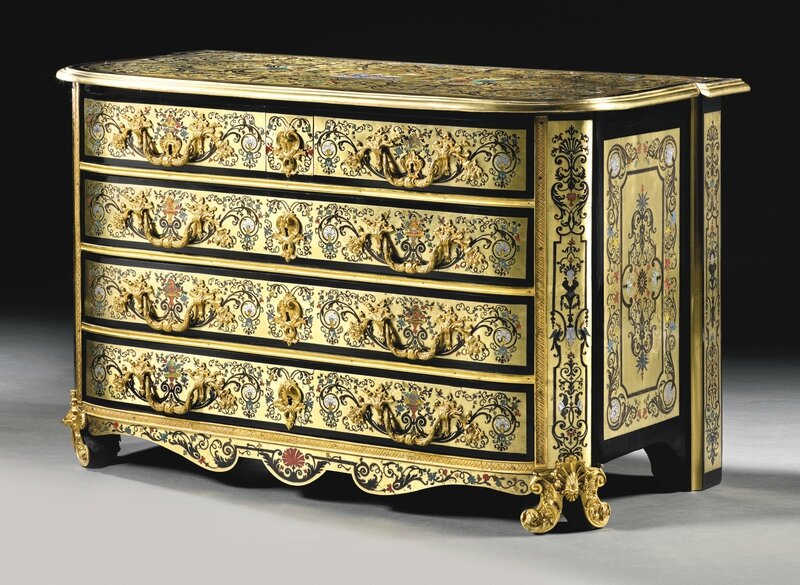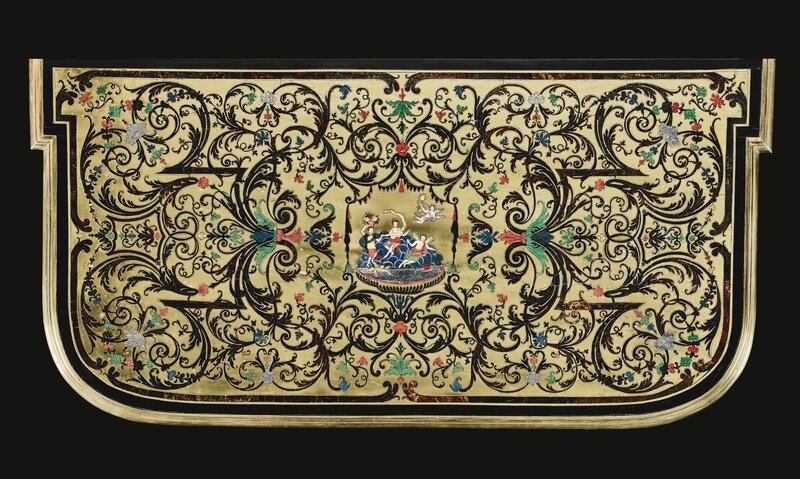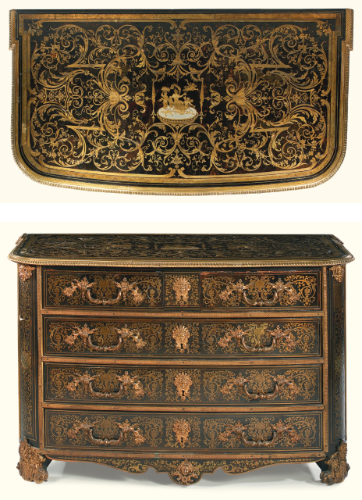A Gilt-bronze Mounted Tortoiseshell, Stained Horn and Brass Boulle Marquetry ebony Commode, Attributed to Nicholas Sageot
Lot 12. A Gilt-bronze Mounted Tortoiseshell, Stained Horn and Brass Boulle Marquetry ebony Commode, Attributed to Nicholas Sageot, circa 1715. Estimate 150,000 — 250,000 GBP. Lot sold 173,000 GBP. Photo Sotheby's
in contre-partie inlaid with polychrome scrolling foliage, flowers and insects, the bowed rectangular top centred by Venus with attendants, above two short and three long drawers, the drop handles cast with bearded masks and cornucopiae, the escutcheons mounted with foliage and rocaille, the rounded corners and side panels with strap-work and scrolling foliage, the shaped apron centred by a red shell and acanthus leaves, on double-scrolled feet; 81cm. high, 132cm. wide, 66cm. deep; 2ft. 8in., 4ft. 4in., 2ft. 2in.
Provenance: Formerly in an English Private Collection.
Comparative Literature: Jean-Dominique Augarde, “Noel Gérard et le Magasin Général à Hôtel Jabach”, Luxury Trades and Consumerism in Ancien Régime Paris, ed. R.Fox and A. Turner, Ashgate, 1998.
Peter Fuhring, “Designs for and after Boulle furniture”, Burlington Magazine, 1071, June 1992, pp. 350-62.
Pierre Grand, “Le mobilier Boulle et les ateliers de l'époque”, L’Estampille-L’Objet d’Art, 266, February 1993, pp. 48-70.
Notes: This commode is part of a group of Boulle marquetry furniture dating from around 1700-1720, traditionally attributed to themarchand-ébéniste Noël Gérard (1690-1736) because of the similarities with a rosewood commode stamped NG (sold Paris, Hôtel Drouot, 2 April 1987, lot 133). Following Pierre Grand’s seminal study (“Le mobilier Boulle et les ateliers de l'époque”,L’Estampille-L’Objet d’Art, 266, February 1993, pp. 48-70), however, part of the group was reattributed to Nicholas Sageot, an attribution further substantiated by the discovery of more pieces bearing his stamp.
In the milieu of 18th century Parisian cabinet-makers, where family and business were often interrelated, ideas circulated freely. In Sageot's times, stamps were still a rarity, and are therefore seldom conclusive as regards the actual maker of a piece, which was the product of several artisans: carpenters for the carcass, marqueteurs and bronziers. This can be observed from the manner in which commodes from the group, sometimes stamped by different ébénistes, all display similar, subtle variants to outline and marquetry.
In fact, it was not unusual for marchand-ébénistes such as Sageot or Gérard to provide marqueteurs with raw materials that would be returned in the form of panels ready to be fitted on to the carcass of the piece. Some of the larger panels could, in effect, be interchangeable; for example, those normally found on the armoires are also found on the sides of most commodes, especially those en arbalète.
As suggested by Grand, the specialist inlayer Toussaint Devoye, a marqueteur with close links to Sageot, might well have provided the marquetry for many of these pieces. He appears to have worked for at least one other cabinet-maker, Pierre Moulin, brother-in-law of Gérard, who also specialised in brass and tortoiseshell furniture and who, at the time of his death, had seven active workshops across Paris. Interestingly, Moulin had purchased part of Sageot’s considerable stock upon the latter’s retirement from business in 1720.
THE MARQUETRY DESIGN
Characterised by a decoration à rinceaux, with drawer-fronts displaying cornucopiae issuing foliate scrolls, this especially popular marquetry design developed from the markedly figurative arabesques of Jean Bérain, typically found on earlier commodes as well as on most bureaux Mazarin. Together with the general shift from red to brown tortoiseshell, this foliate decoration, present on most bow-front commodes, is arguably a result of the strong influence exercised by André-Charles Boulle on his contemporaries.
The front-drawer marquetry, with its fruit-filled tazze and matching handles, is nearly identical to that found on a number of other commodes, including
- one, unattributed, from the Keck Collection, sold Sotheby’s New York, 5 December 1991, lot 245 ($374,000; illustrated here in fig. 1);
- another, stamped Sageot, from the collection of the Dukes of Newcastle at Clumber Park, sold Christie’s London, 16 December 1999, lot 50 (£287,500; fig. 2);
- a third one, also stamped Sageot, sold Christie’s London, 5 July 2012, lot 8.
fig. 1. Commode, formerly in The Keck Collection, La Lanterne, Bel Air, California, sold Sotheby’s New York, 5 December 1991, lot 245.
fig. 2. Commode stamped Nicholas Sageot, formerly in the collection of Dukes of Newcastle, Clumber Park, Nottinghamshire, sold Christie’s London, 16 December 1999, lot 50. Photo © Christie’s Images / Bridgeman Images.
Commode attributed to Nicholas Sageot, circa 1710, sold Sotheby’s London, 4 July 2012, lot 17.
Closely related front, angle and side panels also appear on a commode in première-partie stamped Gaudron, sold Sotheby’s Monaco, 16 June 1990, lot 837.
Finally, the near-exact marquetry design is found on the front of a contre-partie commode attributed to Sageot, sold Sotheby’s London, 4 July 2012, lot 17 (£217,250, fig 4), again with identical handles.
Conversely, the distinctive c-scroll and rocaille escutcheons differ from the espagnolettes normally found on these pieces; identical ones appear:
- on a commode sold Christie’s London, 12 June 1997, lot 16,
- as well as on another attributed to Gérard, sold Sotheby’s London, 7 December 2005.
The shell motif inlaid on the apron of our commode, stemming from designs by Jean Bérain, was also favoured by André-Charles Boulle; it is found on the top of an unattributed contre-partie commode, ill. in Grand, p. 69 and, significantly, on nearly all armoires stamped by Sageot.
AN UNUSUAL TOP
This top is particularly rare among contemporary commodes: shaped to resemble a Roman tablet, with eared corners, it is gently rounded. The central section, recalling the arabesque designs of Jean Bérain, represents the Triumph of Love, with a torch-bearing Cupid guiding Venus, and a basket-bearing attendant, thought to symbolise Peace and Plenty. This is a motif echoed in the drawer fronts and gilt-bronze handles, giving great coherence to the piece.
Two commodes in première- and contre-partie, attributed to Alexandre-Jean Oppenordt, display very similar tops, although with a foliate medallion instead of the figurative group with Venus (sold Christie’s London, 8-9 December 1994, lot 545; Koller Zurich, 28 March 2011, lot 1045). Significantly, an identical top in première-partie is found on the Duke of Newcastle commode, stamped by Sageot (see above, fig. 2).
THE ATTRIBUTION TO NICHOLAS SAGEOT
Nicholas Sageot was born at Samaize-les-Bains in 1666, and founded his atelier around 1690. By 1698 he was certainly working in the Faubourg Saint-Antoine as an ouvrier libre. Received maître in 1706, in 1711 he married the daughter of theébéniste Jacques Roussel. After his retirement in 1720 part of his considerable stock was sold to the marchand-mercierLéonard Prieur for 16,000 livres. Around 1723 he suffered a mental breakdown, was institutionalized in 1725, and died in 1731.
A relatively small number of works stamped by Sageot, or otherwise firmly attributed to him, survive. Together with the two aforementioned commodes, these pieces include, but are not limited to, a bureau Mazarin in the Swedish Royal Collection since the 18th century (inv. HGK.215), illustrated in Grand, p. 50, ill. 2 and 3; one pair of armoires - the first in contre-partie at the Château de Versailles (inv. V3670), the second in première-partie formerly in the collection of the Princes Beloselsky-Belozersky, and a third armoire, or bibliothèque, from the Hohenzollern collection, sold Sotheby’s, Zurich, 1 December 1998, lot 411.
Although ébénistes of the time would share concepts and materials, some owned their own cartoons, or kept their own stock of mounts, and attributions can sometimes be attempted. In this case, certain aspects point to our commode being the product of Nicholas Sageot, namely the distinctively inlaid apron and the top, whose exact counterpart appears on the Duke of Newcastle commode, suggesting that this particular design, combining a markedly foliate decoration with figurative medallions, might have been specific to his atelier.
Manufactured in a comparatively short period of time, and in considerable quantities, this furniture could often be hastily assembled, with mounts, however expensive, disguising blemishes to the body. In this commode, on the other hand, full prominence is given to the handsomely and perfectly fitted marquetry, whose polychrome stained horn is particularly rich, and whose variations - suggestive of careful planning, make it positively unique.
Sotheby's. Old Master Sculpture and Works of Art Including Splendours from a Mantuan Palazzo, London, 05 Jul 2016

/https%3A%2F%2Fprofilepics.canalblog.com%2Fprofilepics%2F1%2F0%2F100183.jpg)
/https%3A%2F%2Fstorage.canalblog.com%2F03%2F02%2F119589%2F96711876_o.jpg)
/https%3A%2F%2Fstorage.canalblog.com%2F11%2F31%2F119589%2F94773502_o.jpg)
/https%3A%2F%2Fstorage.canalblog.com%2F20%2F83%2F119589%2F94772815_o.jpg)
/https%3A%2F%2Fstorage.canalblog.com%2F26%2F72%2F119589%2F75604929_o.jpg)
/https%3A%2F%2Fstorage.canalblog.com%2F59%2F60%2F119589%2F26458628_o.jpg)








/http%3A%2F%2Fstorage.canalblog.com%2F50%2F40%2F119589%2F121027920_o.png)
/http%3A%2F%2Fstorage.canalblog.com%2F04%2F88%2F119589%2F112498983_o.jpg)
/http%3A%2F%2Fstorage.canalblog.com%2F80%2F74%2F119589%2F110526316_o.jpg)
/http%3A%2F%2Fstorage.canalblog.com%2F04%2F63%2F119589%2F110096416_o.jpeg)